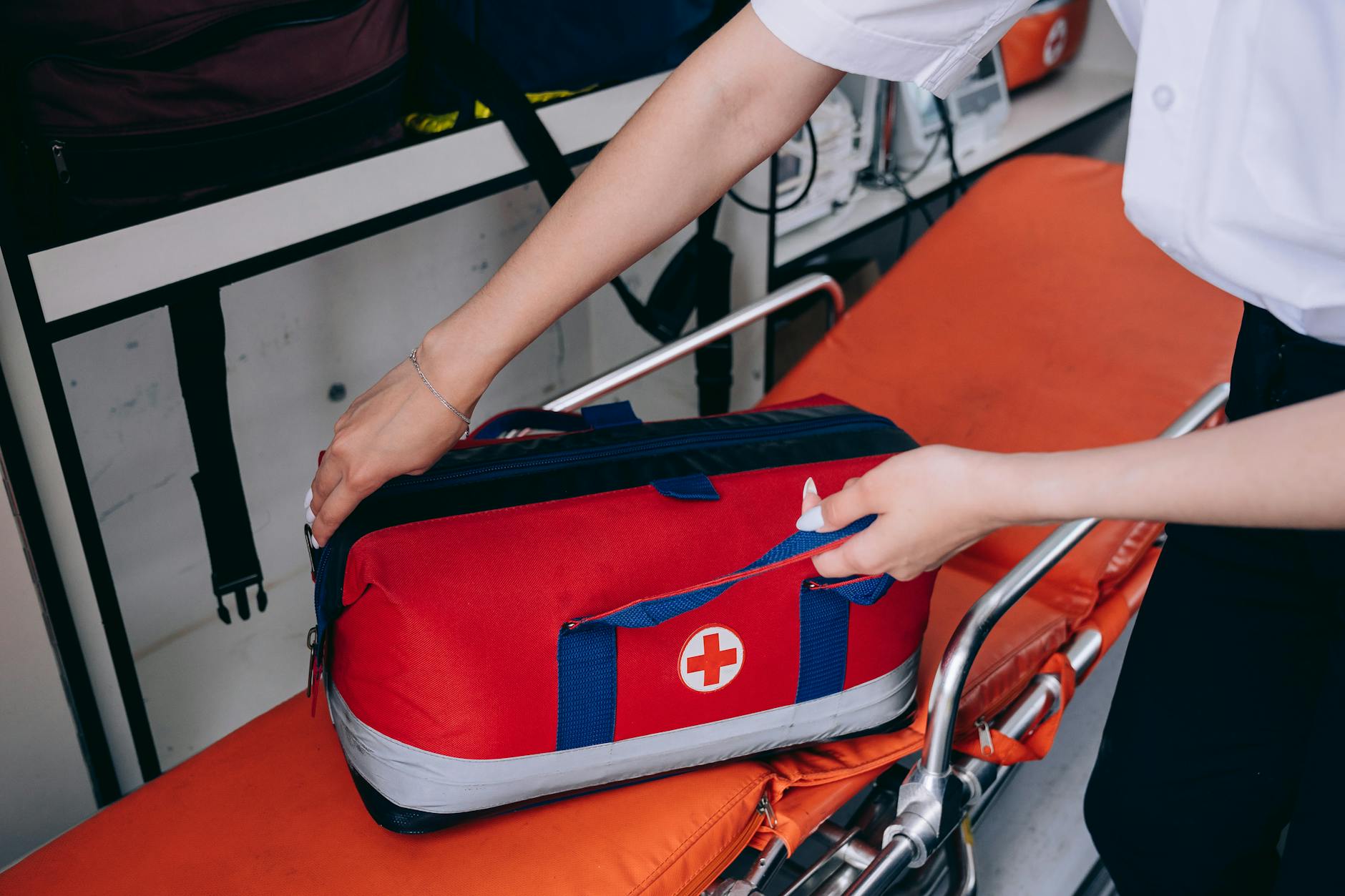Unveiling life-saving secrets: Discover the must-have emergency medical equipment for your kit that could save lives.

Image courtesy of Mikhail Nilov via Pexels
Table of Contents
- Primary Equipment for Initial Assessment and Stabilization
- Advanced Life Support Equipment
- Trauma Kits and Wound Care Supplies
- Diagnostic Tools and Miscellaneous Equipment
- Storage and Maintenance of Emergency Medical Equipment
- Conclusion
Howdy, folks! Today we’re diving headfirst into a topic that could quite literally save lives: emergency medical equipment. When it comes to unexpected emergencies or accidents, having the right supplies on hand can mean the difference between life and death. So, buckle up and get ready for a comprehensive overview of the must-have supplies you need in your emergency medical kit.
First things first, let’s talk about what emergency medical equipment actually entails. Essentially, it’s a collection of essential tools and supplies that are specifically designed to provide immediate medical assistance during emergencies. This can range from basic equipment for initial assessment and stabilization to more advanced life support equipment and even diagnostic tools.
Now, you might be wondering why it’s so important to have these supplies readily available. Well, picture this: You’re in a situation where someone suddenly collapses, or an accident occurs that causes serious injuries. In these critical moments, having the right medical equipment can help you assess the situation, stabilize the individual, and even potentially save their life before professional medical help arrives.
Primary Equipment for Initial Assessment and Stabilization
Let’s start with the basics, shall we? When it comes to initial assessment and stabilization, there are a few key items that should always be in your emergency medical bag. These include:
Stay Prepared: Discover Life-Saving Tools for Your Emergency Medical Kit
Subscribe now and get essential tips to equip yourself for any life-threatening situation.
CPR Masks, Gloves, and Face Shields: Personal protection is paramount, especially in emergency situations. These supplies help protect you from potential pathogens and ensure safe resuscitation efforts.
Splints, Immobilizers, and Bandages: Injuries such as fractures, sprains, or dislocations require stabilization before further medical intervention. Having splints, immobilizers, and bandages readily available can help provide temporary relief and prevent further damage.
Advanced Life Support Equipment
For more serious emergencies that require advanced life support, there are several key pieces of equipment you should have:
Automated External Defibrillators (AED): AEDs can be real lifesavers when it comes to sudden cardiac arrest. These devices provide electric shocks to restore a normal heart rhythm, increasing the chances of survival until professional help arrives.
Cardiac Monitors, Oxygen Tanks, and Airway Management Tools: In critical cardiac or respiratory cases, cardiac monitors, oxygen tanks, and airway management tools are essential. They help monitor vital signs, deliver supplemental oxygen, and ensure a clear airway for the patient.
Intravenous (IV) Supplies and Medications: In some cases, intravenous fluids and medications may be necessary for immediate treatment. Having IV supplies, such as catheters and fluids, along with life-saving medications, can make a world of difference in emergency situations.
“Stay prepared, save lives! 🔥 Discover the essential emergency medical equipment that can make a difference in critical situations. 💼 Learn more at [insert link] and be the hero ready to act when it matters the most. 💪 #LifeSaving #EmergencyPreparedness”
Trauma Kits and Wound Care Supplies
When dealing with trauma or severe wounds, having the appropriate supplies on hand is crucial. Here are a few essentials:

Image courtesy of www.pinterest.com via Google Images
Trauma Kits: Trauma kits are specially designed to provide immediate care for serious injuries until professional medical assistance is available. These kits typically include items such as hemostatic agents, tourniquets, and wound dressings.
Hemostatic Agents and Wound Dressings: These supplies are fundamental in controlling bleeding and promoting proper wound care. Quick and effective wound management is essential for preventing infection and minimizing further complications.
Cleaning and Sterilizing Wound Care Equipment: Proper cleaning and sterilization of wound care equipment cannot be emphasized enough. In an emergency situation, it’s crucial to ensure that the tools you use are clean and sanitized to prevent infection.
Diagnostic Tools and Miscellaneous Equipment
Now let’s talk about some diagnostic tools and miscellaneous equipment you should have in your emergency medical kit:
Diagnostic Tools: Thermometers, stethoscopes, and blood pressure cuffs are simple yet critical tools for assessing a patient’s vital signs. These basic diagnostic tools can provide valuable information to help you make informed decisions regarding treatment.
Emergency Lighting, Radios, and Communication Devices: During emergencies, power outages or loss of communication can occur. Emergency lighting, radios, and communication devices are essential for maintaining contact with others and ensuring clear and effective communication.
Utility Tools: Don’t forget the small but mighty utility tools! Scissors, penlights, and multi-purpose knives can be invaluable in emergency situations when quick and efficient maneuvering is required.
Storage and Maintenance of Emergency Medical Equipment
So, you’ve assembled your emergency medical kit with all the essential supplies. But how do you ensure that the equipment stays in good condition and ready for action? Consider the following:
Proper Storage: It’s important to store your emergency medical equipment in a designated and easily accessible location. This ensures that you can quickly grab it when needed, saving precious time during an emergency.
Maintenance Guidelines: Familiarize yourself with the maintenance guidelines provided with the equipment. Regularly inspect and test all tools to ensure they’re in working order and ready to be put to use at a moment’s notice.
Restocking and Replenishing Supplies: Periodically check your emergency medical kit to make sure all supplies are in date and replenish items as needed. This helps ensure you’re always prepared without any essential supplies running low or being expired.
Stay Prepared: Discover Life-Saving Tools for Your Emergency Medical Kit
Subscribe now and get essential tips to equip yourself for any life-threatening situation.
Conclusion
Well, folks, there you have it—a comprehensive overview of the must-have emergency medical equipment that could one day save a life. Remember, emergencies can strike when we least expect them, so it’s vital to be prepared. By having the right supplies in your emergency medical kit, you become an invaluable asset in providing immediate assistance and potentially making a life-saving impact. Stay informed, stay prepared, and let’s make a difference when it truly matters!




